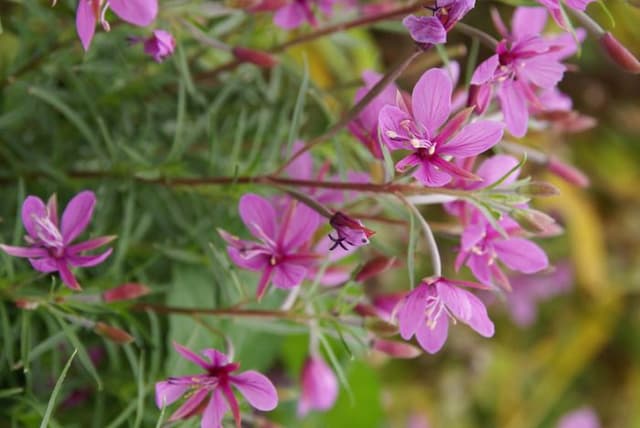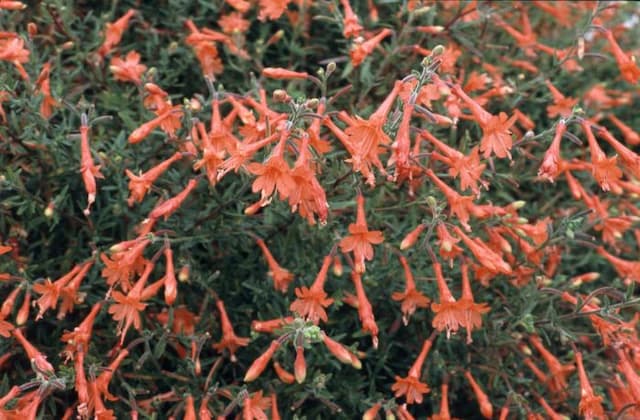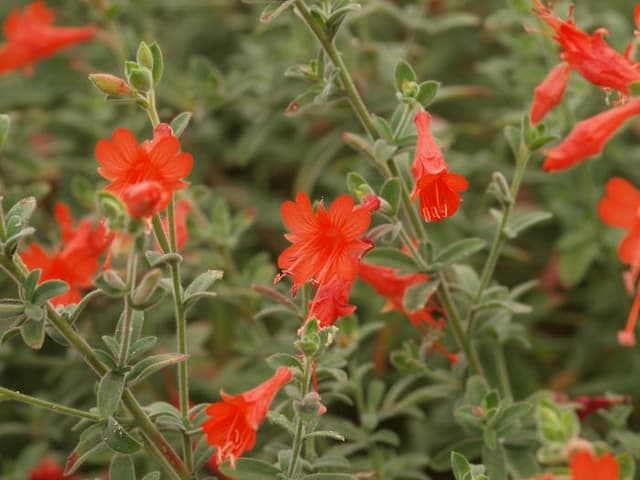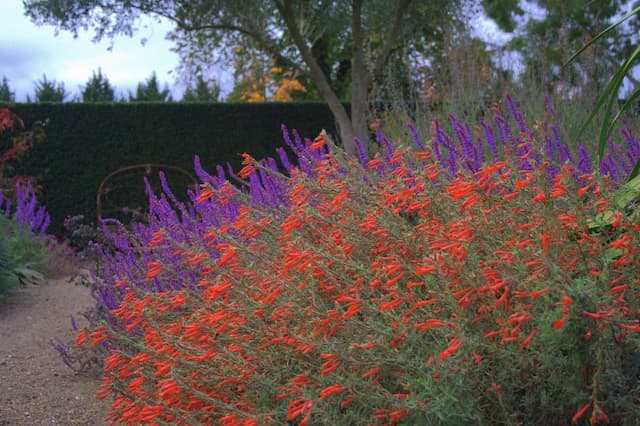Fuchsia Fuchsia 'Ben Jammin'

ABOUT
Fuchsia 'Ben Jammin' is a visually striking plant known for its beautiful, unique flowers and appealing growth habit. The flowers of this variety are particularly eye-catching, featuring a lovely combination of colors that can add a vibrant touch to any garden setting. The blooms are pendent and teardrop-shaped, usually appearing in shades of purple and pink with a gracefully hanging appearance like delicate lanterns. The petals are long, slender, and often slightly recurved, revealing a paler pink or sometimes white inner corolla, giving the flowers a two-toned look that is both elegant and intriguing. The foliage of 'Ben Jammin' is equally attractive, with leaves that are typically green, and they may have a slight bronze tint, which further accentuates the vivid colors of the blooms. The leaves are arranged oppositely along the stems, and they can be somewhat elongated with a slightly serrated edge, offering a lush backdrop to the colorful flowers. 'Ben Jammin' is a garden favorite not only for its stunning blooms and foliage but also for the manner in which it can be used in landscapes. It's often grown in hanging baskets where the trailing habit of the branches and the drooping flowers can be admired from below, or it can be used as a border plant where its upright and arching branches add structure and form to garden beds. Overall, Fuchsia 'Ben Jammin' is known for its distinctive, long-blooming flowers and the elegance they bring to the garden throughout their blooming season. This plant is favored by gardeners who wish to add a splash of color and a touch of grace to their outdoor spaces.
About this plant
 Names
NamesFamily
Onagraceae.
Synonyms
Hardy Fuchsia, Lady's Eardrops.
Common names
Fuchsia 'Ben Jammin'.
 Toxicity
ToxicityTo humans
Fuchsia 'Ben Jammin', commonly known as Fuchsia, is not considered toxic to humans. In general, the Fuchsia genus does not contain any significant toxins that would cause harm if ingested. However, consuming any non-food plant can potentially cause mild stomach upset or an allergic reaction in sensitive individuals. It is always best to exercise caution and keep plants out of the reach of children who may be tempted to taste them.
To pets
Fuchsia 'Ben Jammin', commonly referred to as Fuchsia, is not known to be toxic to pets such as dogs and cats. Most species of Fuchsia, including this one, are considered safe and non-toxic to pets. Therefore, ingestion of this plant should not lead to any significant symptoms of poisoning in pets. However, it is always advisable to prevent pets from eating plants, as individual animals might have different sensitivities, and consuming non-food items can sometimes cause gastrointestinal upset.
 Characteristics
CharacteristicsLife cycle
Perennials
Foliage type
Deciduous
Color of leaves
Green
Flower color
Mixed
Height
1-2 feet (30-60 cm)
Spread
1-2 feet (30-60 cm)
Plant type
Shrub
Hardiness zones
9
Native area
Central and South America
Benefits
 General Benefits
General Benefits- Ornamental Value: The Fuchsia 'Ben Jammin' adds aesthetic appeal to gardens and outdoor spaces with its striking, pendulous flowers.
- Attracts Pollinators: It is known to attract hummingbirds, butterflies, and other pollinating insects, which can help pollinate other plants in the garden.
- Versatility: Suitable for planting in borders, hanging baskets, and containers, offering flexibility in garden design and space utilization.
- Variety of Colors: It produces blossoms in a combination of vibrant colors, which can brighten up any space and offer a variety of visual interest through the flowering season.
- Long Flowering Period: Fuchsia 'Ben Jammin' has a long blooming period, often from spring to fall, providing color for an extended time.
- Shade Tolerance: Unlike many flowering plants, this fuchsia can tolerate shade, making it suitable for areas of the garden that receive less direct sunlight.
- Easy Propagation: Fuchsia plants can be easily propagated from cuttings, allowing gardeners to multiply their plants without buying new ones.
- Low Maintenance: Once established, they require relatively low upkeep beyond regular watering and occasional feeding and pruning.
 Medical Properties
Medical PropertiesThis plant is not used for medical purposes.
 Air-purifying Qualities
Air-purifying QualitiesThis plant is not specifically known for air purifying qualities.
 Other Uses
Other Uses- Fuchsia 'Ben Jammin' can be used as a natural dye for fabrics, imparting delicate hues to textiles depending on the mordant used.
- The plant can serve as a learning tool for botany students to study flower structure and pollination strategies.
- Being non-toxic, fuchsia flowers can be used as decorations for cakes and pastries, adding a vibrant touch to culinary presentations.
- Fuchsias, including 'Ben Jammin', can be used in art to create botanical prints by pressing or hammering the flowers and leaves onto paper.
- When grown in hanging baskets, they provide aesthetic partitioning in open-plan spaces while enhancing the area's visual appeal.
- Their nectar-rich flowers can be used as a natural food source to attract and sustain populations of beneficial insects, like bees and butterflies, for pollinator gardens.
- Fuchsias can be utilized in sensory gardens for their distinct texture and visually stimulating colors to benefit individuals with sensory processing disorders.
- As a component in living walls or vertical gardens, these plants can aid in reducing noise pollution when strategically placed in urban environments.
- They can serve as natural indicators of the ecological health of an environment based on their growth and blooming patterns.
- When used in landscaping designs, fuchsia, including 'Ben Jammin', can help in soil erosion control on slopes due to their bushy growth habit.
Interesting Facts
 Feng Shui
Feng ShuiThe Fuchsia is not used in Feng Shui practice.
 Zodiac Sign Compitability
Zodiac Sign CompitabilityThe Fuchsia is not used in astrology practice.
 Plant Symbolism
Plant Symbolism- Confidence and Boldness: The Fuchsia 'Ben Jammin''s vibrant and striking flowers represent one's ability to stand out and express oneself boldly.
- Grace under Pressure: The delicate nature of the fuchsia's hanging flowers symbolizes maintaining grace and composure when facing life’s challenges.
- Elegance and Taste: Often associated with sophistication, fuchsias are emblematic of good taste and a love for aesthetic beauty.
- Harmony and Balance: The symmetry of the plant's flowers can represent the quest for balance in one’s life.
- Purity and Virtue: The purity of the fuchsia's vivid blooms is sometimes connected to virtuous qualities and moral integrity.
 Water
WaterFor the Fuchsia 'Ben Jammin', or more commonly known as fuchsia, consistent moisture is key, so water with about 16 ounces of water whenever the top inch of soil feels dry to the touch; this could be approximately every other day during the warmer seasons. Reduce watering in the winter, about once a week, as the plant requires less moisture during its dormant period. It’s important not to let the fuchsias dry out completely, nor should they be sitting in water, as this can lead to root rot.
 Light
LightFuchsias, including the 'Ben Jammin' variety, prefer bright, indirect light and should be placed in a spot where they are protected from the harsh midday sun. An ideal location would be a spot that receives morning sunlight and afternoon shade, or dappled sunlight throughout the day, which mimics their native under-canopy habitat.
 Temperature
TemperatureFuchsias like 'Ben Jammin' thrive in cooler temperatures and do best in a range between 55 to 75 degrees Fahrenheit. They can survive temporarily in temperatures as low as 40 degrees Fahrenheit, but sustained exposure to temperatures below or above the 40 to 80 degrees Fahrenheit range can harm the plant. It's crucial to protect the fuchsia from extreme temperatures to prevent heat stress or cold damage.
 Pruning
PruningPruning encourages a bushier growth habit and more flowers for the fuchsia 'Ben Jammin'. Lightly prune in the spring to shape the plant and remove any dead or weak branches. After flowering, a more thorough prune can help to stimulate new growth. The best time to prune heavily is late winter or early spring, before new growth begins.
 Cleaning
CleaningAs needed
 Soil
SoilFuchsia 'Ben Jammin' thrives in a well-draining, fertile potting mix with a pH between 6 and 7. A mix of peat moss, perlite, and loam is often recommended to provide adequate nutrition and moisture retention. Regular feeding with a balanced fertilizer will support robust growth.
 Repotting
RepottingFuchsias, like 'Ben Jammin', should typically be repotted every year to two years, preferably in spring. Due to their rapid growth, upgrading the pot size will ensure they have enough space and nutrients for continued development.
 Humidity & Misting
Humidity & MistingFuchsias like 'Ben Jammin' prefer moderate to high humidity conditions. Aim for a humidity level between 60-70% for optimal growth, but they can tolerate down to 50% if other conditions are favorable.
 Suitable locations
Suitable locationsIndoor
Position Fuchsia 'Ben Jammin' in bright, indirect light and maintain high humidity.
Outdoor
Keep Fuchsia 'Ben Jammin' in dappled sunlight and protect from frost.
Hardiness zone
9-11 USDA
 Life cycle
Life cycleThe Fuchsia 'Ben Jammin', also commonly known as simply a fuchsia plant, begins its life cycle as a seed, germinating in warm, moist soil before sprouting into a seedling with its first set of true leaves. As the fuchsia seedling matures, it grows into a young plant with a bushy habit and many stems, entering a vegetative stage where it develops more leaves and branches. The fuchsia then enters the flowering stage, producing distinctive, pendulous flowers that are typically pink, purple, or white, attracting pollinators such as hummingbirds and bees. Following pollination, the flowers develop into small fruit-bearing structures that contain seeds, which, when mature, can be dispersed by birds or fall to the ground. If environmental conditions are favorable, the dropped seeds may germinate and start a new life cycle, while the parent plant may enter a period of dormancy, especially in cooler climates, to survive harsh conditions. With proper care, including pruning, feeding, and protection from frost, fuchsia plants can live for many years, often treated as perennials, and continue to grow and flower each season.
 Propogation
PropogationPropogation time
Spring-Early Summer
Fuchsia 'Ben Jammin', commonly known as the hardy fuchsia, is often propagated through softwood cuttings. This method of propagation is popular due to its high success rate and the uniformity of the plants produced. Typically, the best time to take softwood cuttings is in late spring to early summer when the plant is actively growing and the stems are green and flexible. A cutting should be taken from the tip of the stem, about 4 to 6 inches (approximately 10 to 15 centimeters) in length, ensuring it has several leaves. The lower leaves are removed and the cut end dipped in rooting hormone before it is placed into a potting medium that drains well. The cuttings should be kept under high humidity and indirect sunlight until they have rooted, which usually takes a few weeks. Once rooted, the new plants can be gradually acclimatized to normal conditions and eventually transplanted outdoors if the climate is suitable.









